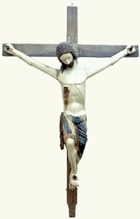

The civic art collection of Gualdo Tadino is exhibited in a series of rooms in Rocca Flea. The exhibits include frescoes in the church (possibly Sant’ Angelo de Flea) under the main tower: these are described in the page on Rocca Flea.
Christus Patens (13th century)
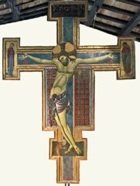
I(ESUS C(RUSTUS) NAZARENU(S)
REX IUDEORU(M)
Jesus Christ of Nazareth, King of the Jews
The crucifix, which was probably painted for the friars’ first church inside the city walls, was documented in ca. 1870 in the sacristy of the later church of San Francesco. It was restored in 1919 and again in 1938. Its relationship to other contemporary Franciscan crucifixes is a matter of debate: the gallery attribution is to the otherwise unknown Maestro del Crocifisso di Gualdo Tadino.
Standing Saints (14th century)
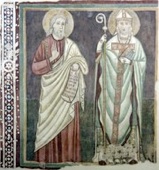
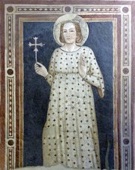
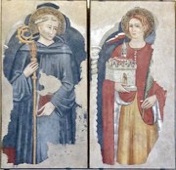
These frescoes were detached from a wall in the Poor Clares’ church of Santa Margherita in 1935. They depict:
-
✴SS Mark and (probably) Facondinus;
-
✴St Margaret (identified when the tail of a dragon was discovered to the lower right during a recent restoration); and
-
✴St Louis of Toulouse and an unidentified saint (perhaps St Venantius of Camerino).
Crucifix (14th century)
Dossal (15th century)
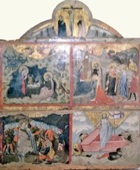
-
✴the Crucifixion with the Virgin and St John the Evangelist, at the pinnacle;
-
✴two scenes in the upper register:
-
•the Nativity; and
-
•the Adoration of the Magi; and
-
✴two scenes in the lower register:
-
•the Capture of Christ; and
-
•the Resurrection.
The panel was probably part of a triptych.
Polyptych (15th century)
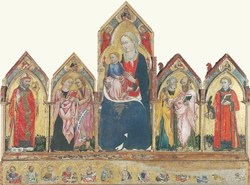
This polyptych from the high altar of San Facondino, which was selected for transfer to the civic collection in 1888, was probably actually transferred after its inclusion in an exhibition of 1907. The polyptych depicts:
-
✴the Madonna and Child enthroned with two angels, in the main panel;
-
✴two pairs of saints to the sides:
-
•SS John the Evangelist and John the Baptist, on the left; and
-
•SS Peter and Paul, on the right;
-
✴two saints at the extremes:
-
•St Facondinus, on the left; and
-
•St Laurence, on the right;
-
✴figures in tondi of the Christ and the Evangelists, in the trilobes above the panels; and
-
✴figures in tondi of the resurrected Christ and the Apostles, in the predella.
Coronation of the Virgin (15th century)
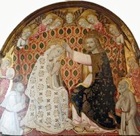
A note that seems to have been attached to the panel in the 19th century claimed that it belonged to one of the monks of SS Gervasio e Protasio at Capodacqua (outside Gualdo Tadino) and gave the date, 1474. It identified the praying figures below as Bl Angelus and Blessed Andrea di Paolo: the latter had founded the congregation in 1328.
However, Enzo Storelli (referenced in the page on the Congregazione del Corpo di Cristo) has identified these kneeling figures as the Blessed John Colombini and St Jerome. Since the former had founded the Gesuati in 1360 and since this order had a particular reverence for St Jerome, he suggested that the panel was almost certainly painted for one of its churches. However, its provenance is unknown before 1872, when it was documented in the sacristy of San Francesco. Enzo Storelli also dated the work to ca. 1445.
Triptych (15th century)
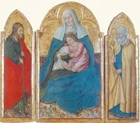
-
✴St Anne and the baby Mary, in the central panel;
-
✴St Joachim, on the left; and
-
✴St Joseph, on the right.
San Francesco Polyptych (1471)
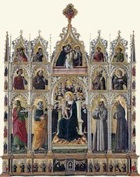
The main panels depict
-
✴the Madonna and Child enthroned with angels;
-
✴SS Paul and Peter on the left; and
-
✴SS Francis and Bernardino of Sienna on the right.
The other panels depict, from left to right:
-
✴in the upper register:
-
•St Christopher, with the baby Jesus;
-
•St Clare;
-
•Christ blessing;
-
•St Stephen; and
-
•St Julian;
-
✴in the lower register:
-
•St Secondus;
-
•St Antony of Padua;
-
•the Pietà with the Virgin and St John the Evangelist;
-
•St Louis of Toulouse; and
-
•St Michael.
The standing figures in the side pilasters probably depict Apostles.
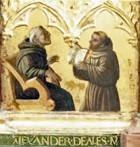
-
✴King Robert of Naples and Pope Alexander V, on the left;
-
✴Pope Nicholas IV and Cardinal Matthew of Acquasparta, on the right;
-
✴at the extreme, the delightfully short-sighted Fr Alexander of Hales, who reads from a book held for him by a young friar (illustrated here).
Works by or attributed to Matteo da Gualdo
Madonna and Child with saints (1462)
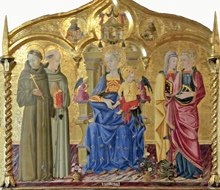
This altarpiece from Santa Margherita is the earliest surviving signed and dated work by Matteo da Gualdo. It depicts the Madonna and Child with angels and flanked by SS Francis, Bernardino of Siena and SS Margaret of Antioch and Catherine of Alexandria. SS Bonaventure and Louis of Toulouse in tondi above flank a tondo containing a tabernacle: this probably alludes to the role of the Madonna as a tabernacle housing the unborn Christ during her pregnancy.
Madonna and Child with saints (1471)
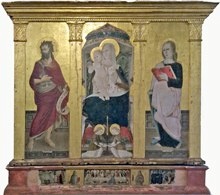
This altarpiece, which is signed by Matteo da Gualdo and dated by inscription, was documented in the Monastero di San Nicolò dei Silvestrini in 1871, as it was about to enter the civic collection. Its original location is unknown. It depicts Madonna and Child with angels and SS John the Baptist and John the Evangelist. The predella panels depict:
-
✴the Baptism of Christ by St John the Baptist;
-
✴the Last Supper; and
-
✴St John the Evangelist raising the widow Drusiana from the dead.
Madonna and Child with saints (1477)
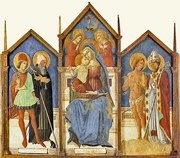
This altarpiece from the parish church of Santa Maria di Pastinaria is dated by inscription and attributed to Matteo da Gualdo. It depicts:
-
✴the Madonna and Child enthroned, with angles flanked a Crucifix in a tondo above:
-
✴SS Secundus and Antony Abbot, on the left; and
-
✴St Sebastian and a bishop saint, on the right.
Santa Maria di Pastinaria was a possession San Secondo, Gubbio, which accounts for the presence of St Secundus and suggests that the bishop saint is probably St Ubaldus.
Triptych (1480)
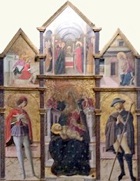
-
✴The main panels depict:
-
•the Madonna and Child enthroned, with angels;
-
•St Sebastian, on the left; and
-
•St Roch, on the right.
-
✴The smaller, upper panels depict the Presentation at the Temple, flanked by figures of the Annunciation.
Processional Banner (1496)
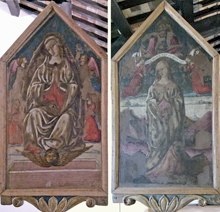
This double-sided banner, which came from Santa Maria Assunta di Nasciano, is attributed to Matteo da Gualdo. The date is known from an inscription that is now illegible. The sides depict, respectively:
-
✴the Assumption of the Virgin; and
-
✴the Immaculate Virgin.
Genealogy of the Virgin (1497)
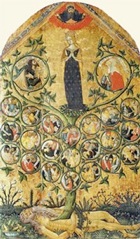
Annunciation (15th century)
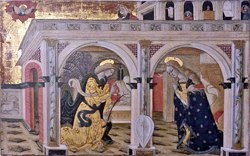
This panel from SS Annunziata is attributed to Matteo da Gualdo.
Madonna and Child in glory (16th century)
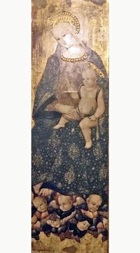
Panels (16th century)
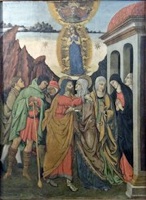
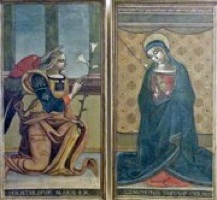
These three panels from Santa Maria dei Raccomandati, which were probably on the high altar, are attributed to Girolamo di Matteo da Gualdo. They comprise:
-
✴a panel of the Immaculate Conception, in which SS Joachim and Anne kiss beneath an apparition of the Immaculate Virgin in a mandorla, with God the Father above; and
-
✴panels of the figures of the Annunciation, which probably flanked the first panel in the original location.
God the Father with saints (ca. 1528)
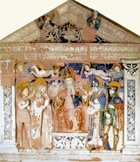
-
✴The main part of the relief depicts God the Father enthroned with the Virgin and St Facondinus, flanked by the plague saints, SS Sebastian and Roch. Angels above hold the Host, representing the crucified Christ.
-
✴Figures of the Annunciation (a reference to the Holy Spirit) are inserted in the frame of the tympanum.
-
✴The predella depicts God the Father in a tondo flanked by male and female members of the Confraternita della SS Trinità (who owned the hermitage and who presumably commissioned the altarpiece.
Baptism of Christ (ca. 1544)
This panel from the Cappella di San Giovanni Battista in Rocca Flea is attributed to Francesco de’ Rossi. (This artist is known as Francesco Salviati because he enjoyed the patronage of Cardinal Giovanni Salviati, the commissioner of the chapel). The panel entered gallery in 1880.
Assumption of the Virgin (16th century)
This damaged panel, which came from the Altare dell’ Assunta in San Francesco, is attributed to Bernardo di Girolamo di Matteo da Gualdo. It depicts the Virgin against a landscape in which St Jerome meditates on the crosses on Golgotha. God the Father and angels are represented above. The crowd that witnesses the scene is largely made up of figures in the red garb of the Confraternita della Trinità, to whom the altar belonged.
SS Augustine and Catherine of Alexandria (16th century)
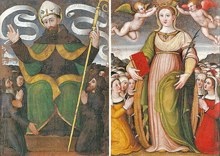
These two small canvases almost certainly came from Sant’ Agostino, the seat of the Confraternita di SS Agostino e Caterina, and were probably used by the confraternity in processions. The canvases, which are attributed to Luca Nucci (probably the father of Avanzino Nucci, below), depict:
-
✴St Augustine enthroned, with members of the confraternity; and
-
✴the standing St Catherine crowned by putti, with female associate members of the confraternity.
Madonna and Child with saint (16th century)
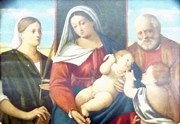
This panel from Santa Margherita depicts the Madonna and Child with SS Catherine of Alexandria and Joseph and the young St John the Baptist.
St Sebastian (16th century)
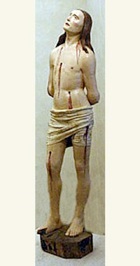
Madonna and Child (16th century)
This pseudo-Byzantine icon is from SS Annunziata.
Works of Alvanzino Nucci
The following altarpieces in the gallery are by or attributed to Avanzino Nucci:
Miracle of St Diego of Alcalá (1627)
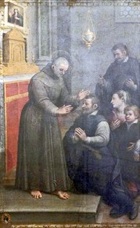
Madonna and Child with saints (17th century)
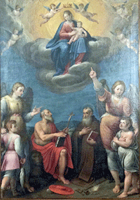
Works of Francesco Allegrini
The following altarpieces in the gallery are by or attributed to Francesco Allegrini:
Madonna and Child with saints (ca. 1668)
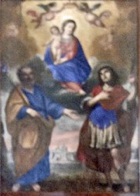
Panels (17th century)
These panels, which are attributed to Francesco Allegrini, probably came from Palazzo Comunale. They depict:
-
✴the Judgement of Solomon; and
-
✴Lot and his Daughters.
St Antony Abbot (17th century)
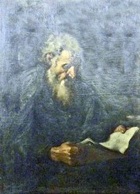
Doors from Sant’ Agostino (date?
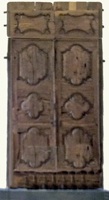
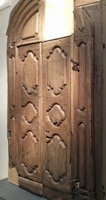
These two doors came from Sant’ Agostino.
